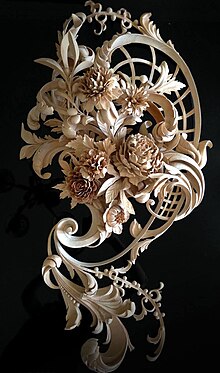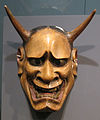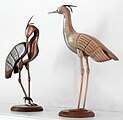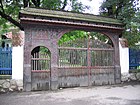利用者:加藤勝憲/木彫


木彫りとは、片手に刃物(ナイフ)、両手にノミ、あるいは片手にノミ、片手に木槌を使い、木彫りの人物や置物、あるいは木製のオブジェに彫刻的な装飾を施すこと。このフレーズは、個々の彫刻から、トレーサリーの一部を構成する手仕事のモールディングまで、完成品を指すこともある。
Wood carving is a form of woodworking by means of a cutting tool (knife) in one hand or a chisel by two hands or with one hand on a chisel and one hand on a mallet, resulting in a wooden figure or figurine, or in the sculptural ornamentation of a wooden object. The phrase may also refer to the finished product, from individual sculptures to hand-worked mouldings composing part of a tracery.
木材を使った彫刻は非常に広く行われてきたが、石や青銅のような他の主な素材ほど、腐敗や虫害、火災に弱く、損傷せずに生き残ることはない。そのため、多くの文化の美術史において重要な隠れた要素を形成している。[1] 屋外の木の彫刻は、世界のほとんどの地域では長持ちしないため、トーテムポールの伝統がどのように発展したかはまだわかっていない。特に中国と日本の最も重要な彫刻の多くは木彫りであり、アフリカやオセアニアなどの彫刻の大部分も木彫りである。木は軽く、非常に細かいディテールを表現できるため、仮面や身につけたり持ち運んだりする彫刻に非常に適している。また、石よりもはるかに加工しやすい[要出典]。
The making of sculpture in wood has been extremely widely practised, but doesn't survive undamaged as well as the other main materials like stone and bronze, as it is vulnerable to decay, insect damage, and fire. Therefore, it forms an important hidden element in the art history of many cultures.[1] Outdoor wood sculptures do not last long in most parts of the world, so it is still unknown how the totem pole tradition developed. Many of the most important sculptures of China and Japan, in particular, are in wood, and so are the great majority of African sculpture and that of Oceania and other regions. Wood is light and can take very fine detail so it is highly suitable for masks and other sculpture intended to be worn or carried. It is also much easier to work on than stone.[要出典]
ヨーロッパ初期の木彫りの現存する最も素晴らしい例は、ドイツ、ロシア、イタリア、フランスの中世のものである。イギリスでは、オーク材が好まれた16世紀から17世紀にかけての完全な作例が数多く残っている。
Some of the finest extant examples of early European wood carving are from the Middle Ages in Germany, Russia, Italy and France, where the typical themes of that era were Christian iconography. In England, many complete examples remain from the 16th and 17th century, where oak was the preferred medium.
最古の木彫り彫刻であるカラマツから彫られたシギル偶像は、約1万2000年前のものだ。
The oldest wood carved sculpture, the Shigir Idol carved from larch, is around 12,000 years old.
方法とスタイル
[編集]- Chip carving
- Relief carving
- Scandinavian flat-plane
- Lovespoon
- Treen
- Whittling
- Chainsaw carving
- Florentine carving
テクニック
[編集]パターン、ブロッキング、ディテーリング、サーフェシング、スムージング
Tools
[編集]

Basic tool set
[編集]- the carving knife: a specialized knife used to pare, cut, and smooth wood.
- the gouge: a tool with a curved cutting edge used in a variety of forms and sizes for carving hollows, rounds and sweeping curves.[2]
- the coping saw: a small saw that is used to cut off chunks of wood at once.
- the chisel: large and small, whose straight cutting edge is used for lines and cleaning up flat surfaces.[2]
- the V-tool: used for parting, and in certain classes of flat work for emphasizing lines.
- the U-Gauge: a specialized deep gouge with a U-shaped cutting edge.
- sharpening equipment, such as various stones and a strop: necessary for maintaining edges.
A special screw for fixing work to the workbench, and a mallet, complete the carvers kit, though other tools, both specialized and adapted, are often used, such as a router for bringing grounds to a uniform level, bent gouges and bent chisels for cutting hollows too deep for the ordinary tool.[2]
| Term | Definition |
|---|---|
| Gouge | Carving tool with a curved cutting edge. The most used category of carving tools. |
| Sweep | The curvature of the cutting edge of a carving gouge. A lower number (like #3) indicates a shallow, flat sweep while a high number (like #9) is used for a deeply curved gouge. |
| Veiner | A small deep gouge with a U-shaped cutting edge. Usually #11 sweep. |
| Fluter | A larger #11 sweep gouge with a U-shaped cutting edge. |
| Sloyd knife | A whittling knife having a strong, blade slightly shorter than the handle (around 5 inches), suitable for marking or carving. |
| Chisel | A carving tool with a straight cutting edge (usually termed #1 sweep) at right angles (or square too) the sides of the blade. |
| Skew chisel | A chisel with the edge at a "skew" or angle relative the sides of the blade. Often termed #2 sweep in the Sheffield list or #1s in continental lists. |
| V-tool | A carving tool with a V-shaped cutting edge.[3] Used for outlining and decorative cuts. Referred to as 'the carvers pencil' by old-time professional carvers. |
| Parting tool | |
| Long bent | A gouge, chisel or V tool where the blade is curved along its entire length. Handy for deep work. |
| Short bent | A gouge, chisel or V tool where the blade is straight with a curve at the end, like a spoon. Use for work in deep or inaccessible areas. Spoon gouges were often referred to as 'tracery tools' which indicates their use in the type of decorative carving found in churches |
| Spoon | |
| Fishtail | A gouge or chisel with a straight, narrow shank that flares out at the end to form a "fishtail" shaped tool. The narrow shaft of the tool allows for clearance in tight areas. |
| Back bent | A spoon gouge with a reverse bent end. Used for undercuts and reeding work. |
| Palm tools | Short (5"), stubby tools used with one hand while the work is held in the other. Great for detail and small carving. |
| Full-size tools | 10" to 11" tools used with two hands or a mallet. |
| Tang | The tapered part of the blade that is driven into the handle. |
| Bolster | A flared section of the blade near the tang that keeps the blade from being driven further into the handle. |
| Ferrule | A metal collar on the handle that keeps the wood from splitting when the tool is used with a mallet. Some tools have an external, visible ferrule while others have an internal ferrule. Some old, small detail tools have neither bolster nor ferrule as their light use makes them unnecessary. |
| Rockwell hardness | A scale that indicates the hardness of steel. A Rockwell range of 58 to 61 is considered optimum for fine woodworking edge tools. |
Wood carving process
[編集]Selection
[編集]The nature of the wood being carved limits the scope of the carver in that wood is not equally strong in all directions: it is an anisotropic
彫刻する木の性質は、木がすべての方向に同じ強度を持つわけではないという点で、彫刻家の範囲を限定する。木が最も強くなる方向は「木目」と呼ばれる(木目はまっすぐなもの、連なったもの、波打ったもの、フィドルバックなど)。デザインの繊細な部分は、木目を横切るのではなく、木目に沿って配置するのがスマートである[2]。しかし、デザインには異なる方向に複数の弱点があったり、木目に沿って配置すると端木目に細部を彫る必要がある(これはかなり難しい)ため、代わりに「ベスト・フィット・ライン」が採用されることも多い。カービング・ブランクはまた、回転木馬のように小さな板を何枚も組み合わせて作ることもある。あまり一般的ではないが、これと同じ原理が無垢の木片にも使われており、2本の枝の分かれ目を利用して木目を発散させたり、大きな丸太の枝をくちばしに彫ったりする(これは伝統的なウェールズの羊飼いのかぎや、ネイティブ・アメリカンの斧の柄に採用されている技法である)。このような基本的なルールを理解していないことは、破損した作品に常に見受けられ、木目を横切って配置された蔓や鳥のくちばしの先端などが壊されている一方で、木の成長と調和し、あまり深く削られずにデザインされた同様の細部がそのまま残されていることに気づくだろう[2]。
Probably the two most common woods used for carving in North America are basswood (aka tilia or lime) and tupelo; both are hardwoods that are relatively easy to work with. Chestnut, butternut, oak, American walnut, mahogany and teak are also very good woods; while for fine work Italian walnut, sycamore maple, apple, pear, box or plum, are usually chosen.[2] Decoration that is to be painted and of not too delicate a nature is often carved in pine,[2] which is relatively soft and inexpensive.
Sculpture
[編集]
laminated
木彫り職人は、作りたい図形の大きさや形に近い木の塊を選ぶことから新しい彫刻を始めるが、大きな彫刻を作る場合は、必要な大きさになるように何枚かの木を張り合わせることもある。木の種類は重要だ。広葉樹は形を作るのが難しいが、光沢があり長持ちする。柔らかい木は彫りやすいが、傷つきやすい。どんな木でも彫ることはできますが、それぞれ性質や特徴が異なる。例えば、細かいフィギュアを彫るには、木目が細かく、フィギュアがほとんどない木材が必要である。
彫刻家は木材を選んだら、さまざまな大きさのガウジを使って大まかな形を整える作業に入る。ガウジは湾曲した刃で、木の大きな部分を滑らかに削ることができる。より硬い木材の場合、彫刻家は35度くらいの強い面取りをしたガウジと、石彫り職人のような木槌を使うこともある。ガウジとチゼルという言葉は混同されやすい。正しくは、ガウジは断面が湾曲した工具で、チゼルは断面が平らな工具である。しかし、プロの彫刻家は、それらをすべて「チゼル」と呼ぶ傾向がある。小さな彫刻ではナイフを、大きな作品ではノコギリを使うこともある。どんな木を選んでも、どんな道具を使っても、木彫り師は常に木目を横切るか、木目に沿って彫らなければならない。
大まかな形ができあがったら、彫り師は細部を作るためにさまざまな道具を使う。例えば、"ヴェイナー "や "フリューター "は、表面に深い溝を作るのに使われる。"Vツール "は、細い線や装飾的なカットを作るのに使われる。細かなディテールが加わったら、木彫り職人は表面を仕上げる。どの方法を選ぶかは、表面の仕上げに要求される品質による。浅い抉りによって残るテクスチャーは、彫刻の表面に「生命力」を与え、多くの彫り師はこの「工具を使った」仕上げを好む。完全に滑らかな表面が必要な場合は、平らな刃の表面に尖った歯がついた「ラスプ」のような道具を使って、一般的な平滑仕上げを行うことができる。「リフラー」はラスと似ているが、より小さく、通常は両刃で、折り目や隙間の作業用に様々な形状のものがある。より細かい研磨は研磨紙で行う。表面が粗い目の大きな研磨紙が最初に使われ、彫刻家はその後、彫刻の表面をつるつるした手触りにすることができる目の細かい研磨紙を使う。
カービングと仕上げが終わると、作家はクルミ油や亜麻仁油など、汚れや湿気から木材を保護するさまざまな天然オイルで木材を密封し、着色することがある。オイルはまた、木に光沢を与え、光を反射することによって、観察者が形を「読む」のを助ける。光沢のあるワニスを塗ると表面がピカピカになりすぎ、光を反射しすぎて形が見えにくくなるため、彫刻家はこれを「タフィーアップル効果」と呼ぶ。木で作られたオブジェは、木を保護し、柔らかな光沢を与えるワックスの層で仕上げられることが多い。ワックス仕上げ(靴墨など)は比較的壊れやすく、屋内の彫刻にしか適さない。
Traditions
[編集]The making of decoys and fish carving are two of the artistic traditions that use wood carvings.
Gallery
[編集]See also
[編集]- List of woodcarvers
- Chainsaw carving
- History of wood carving
- Woodcut
- Woodturning
- Woodworking
- Wood carving in the Marquesas Islands
- Woodcarved Catholic saints in the Parish Church of Ortisei, northern Italy
- National Wood Carvers Association
- Woodcarving events:
- Woodfest Wales
- Arborglyph, carvings made in the bark of living trees
References
[編集]- ^ See for example Martin Robertson, A shorter history of Greek art, p. 9, Cambridge University Press, 1981, ISBN 0-521-28084-2, ISBN 978-0-521-28084-6 Google books
- ^ a b c d e f g
 この記述にはアメリカ合衆国内で著作権が消滅した次の百科事典本文を含む: Chisholm, Hugh, ed. (1911). "Wood-Carving". Encyclopædia Britannica (英語) (11th ed.). Cambridge University Press.
この記述にはアメリカ合衆国内で著作権が消滅した次の百科事典本文を含む: Chisholm, Hugh, ed. (1911). "Wood-Carving". Encyclopædia Britannica (英語) (11th ed.). Cambridge University Press.
- ^ “12 top tips for using a V-tool”. WoodworkersInstitute.com (14 May 2010). 30 January 2013閲覧。
Template:Woodworking* Template:NARA
External links
[編集]- Woodcarving Magazine
- Best Wood for Carving
- India Tamil Nadu's Thammampatti Wood Carving to get 'Geographical Indication' tag
Template:Decorative artsTemplate:Decorative artsTemplate:WoodworkingTemplate:Woodworking [[Category:木工]] [[Category:木彫]] [[Category:未査読の翻訳があるページ]]



























